Everyone likes art in some form, be it a classic da Vinci painting or the masterful stroke of a folding chair to the skull in the hands of “Macho Man” Randy Savage. There truly is something for everyone, but the question must be asked: what is art? What isn’t art? While no one has the right to rule this way or that, the following five examples may open your mind to the idea of what constitutes art.
1.
Blood Art
If there’s one thing that we non-cyborg living beings have in common, it’s that we bleed blood and not some kind of motor oil. If the goal of art is to make something for an audience, then it would make sense to make art with a medium that everyone can relate to, right?
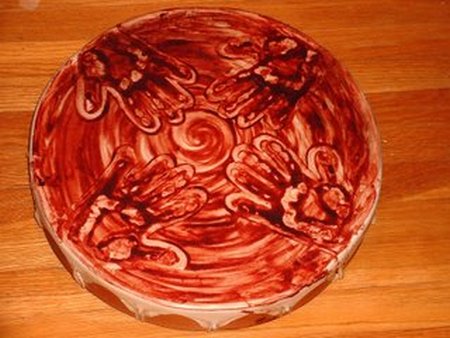
Blood art is exactly what you think it is and naturally not everyone is on board with the idea of it. For the longest time popular culture has taught us that only serial killers paint anything with blood, so the idea of, say, menstrual blood art, comes off as a tad creepy.
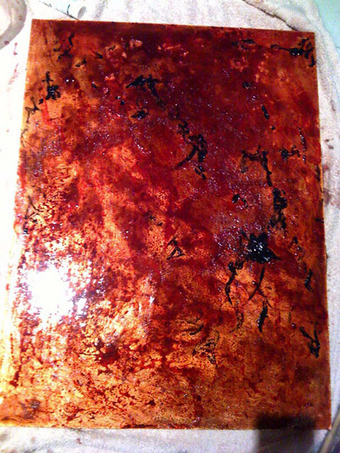
Indeed, some people truly bleed for their art.
Whenever blood art is the subject of conversation questions about hygiene and disease are sure to follow. When done properly these pieces carry no more risk than your standard oil painting. Also, they tend to fade quickly since, you know, blood.
As off this writing it is illegal to sell blood paintings on eBay (and that particular policy isn’t likely to change any time soon since, you know, blood), the reasoning being that it violates the policy on selling human body parts. This has done little to deter the popularity of the medium, however; in March 2011 the Krause Art Gallery in New York City showcased an entire exhibition made with slaughterhouse blood.
2.
Bone Art
Okay, so we can’t agree on blood. But there’s something else that human beings have in common: bones.
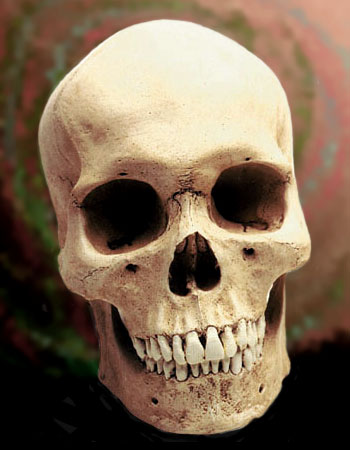
In the mid-nineties, Francois Robert won three lockers at auction. One of those lockers contained a human skeleton. Usually, this is the point where an episode of CSI would break out, but upon further investigation the skeleton, while real, had been wired together for use in a classroom. Relieved, Robert decided to trade the skeleton for two-hundred and six separate human bones.
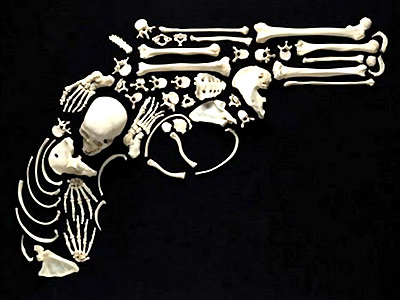
Annnnnd back to CSI.
Robert arranges the bones in six-foot wide iconic images before photographing them. The project, called “Stop the Violence,” is comprised of images associated with death. The shoots take an entire day to set up but the results speak for themselves.
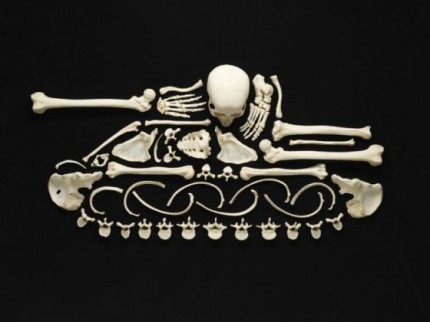
Robert’s own fear of death motivates him to create the image, though there is a message here. As Robert explains, “…I wanted to show that sadly the human skeleton is often all that remains from such acts of violence. This is what you are left with after war – a body count.”
3.
Taxidermy Art
We’ve covered blood and bones. Screw it, let’s go all in: let’s use corpses.
Taxidermy is already an art that makes many people queasy. After all, what you’re looking at is a dead creature dolled up for display. However, some artists have taken this further and begun exploring other concepts through taxidermy.
Geza Szollosi has taken a unique approach to taxidermy: after removing the skin it is then applied to a shape different from the animal’s original skull. The end results are some of the most adorable-yet-horrifying beach balls you’re likely to see this swim suit season:
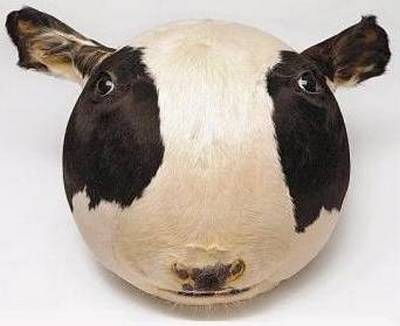
Meanwhile, New Zealand taxidermist Lisa Black has gained a following in the steam punk community for combining animals with machine parts, creating creatures that wouldn’t look out of place murdering a mad scientist before breaking out of the lab and taking the city hostage.
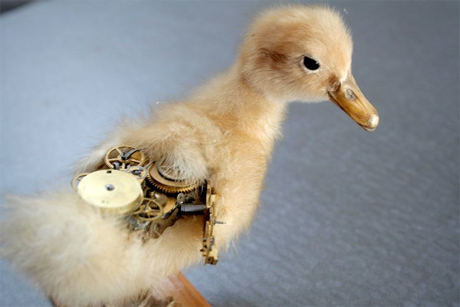
Well, on a smaller scale, anyway.
If you think taxidermy in general is horrifying, Scott Bibus agrees with you. At least, that’s what his “Anti-Trophies” seems to suggest.
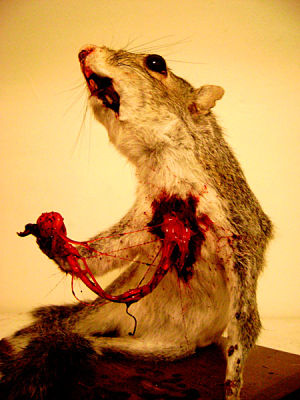
I could write a joke here, but nothing is going to change the fact that that squirrel is tearing out its own heart.
Hosted at the properly named deadanimart.com, the gallery offers everything on the label by capturing scenes of animals in their most agonizing moments. This has proven to be very controversial, but none of the subjects were harmed to create the images.
4.
Mass Photography
Before the advent of digital manipulation, photographer Arthur Mole, armed only with a simple camera and a whole bunch of willing participants, created a series of mass photographs, using hundreds to thousands of people to create a larger image as a collective. His best known piece is a portrait of Woodrow Wilson, which would later serve as the inspiration for the arcade game Sinistar.
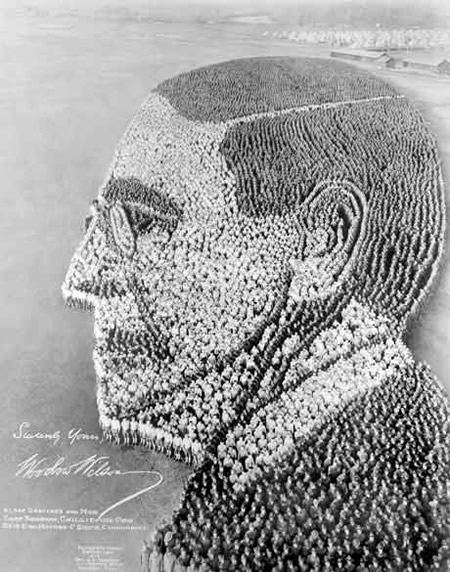
Beware – I live.
Comprised of some twenty-one thousand soldiers, the portrait is highly detailed but at the same time doesn’t try to mask the individuals who make the giant disembodied head of Wilson. Everything about the composition down the perspective of the photograph was taken into consideration beforehand.
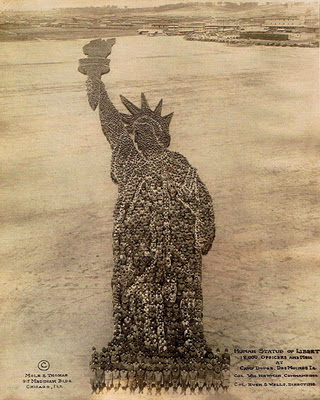
Despite taking less people to produce, this image of the Statue of Liberty didn’t go nearly as smoothly. To get the full gray scale effect the men wore woolen uniforms. The temperature reached one-hundred and five degrees Fahrenheit, but before a full-scale military riot could break out people started fainting. The image was supposed to be used to promote war bonds. Despite all the trouble these guys went through, that never happened.
5.
Etch-A-Sketch
Toys have long held a place in the art world. Perhaps the most famous of these pieces are Lego sculptures, ranging from “incredibly detailed” to “who would waste their life doing this?”
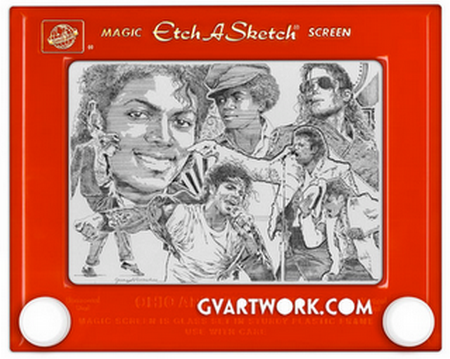
The Etch-A-Sketch, however, was intended for art. Just how effective is it for this purpose? Just ask George Vlosich III, Etch-A-Sketch master and possible highlander.
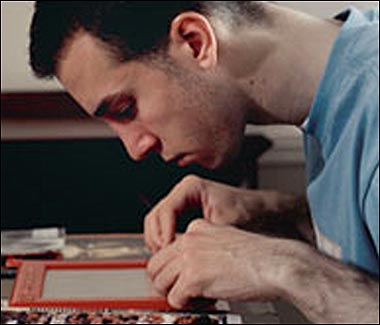
There can be only one.
Since the wee age of ten, George has been harnessing his Etch-A-Sketch skills, winning contests and blowing minds. Now his hobby has become his craft: many of his final pieces are displayed in galleries and some sell for as high as ten-thousand dollars.
According to George’s website, each piece takes between seventy to eighty hours to complete. He begins by taking a sketch, creating the contour with the Etch-A-Sketch, then moves into the most time consuming part – the shading. Depending on the weight of the line each line may be traced anywhere from ten to thirty times each. Then, to ensure that week he spent twisting plastic little knobs don’t go to waste, he takes the toy apart and remove excess powder and the stylus, thus rendering the image permanent.
Written by NN – Copyrighted © www.weirdworm.net
Image Sources
Image sources:
- – Blood Art: http://2.bp.blogspot.com/_RlMPSC0nnvw/Sn0r4oZwLtI/AAAAAAAAB6I/gfKWqVlT-mU/s400/A12.jpg http://myperiodblog.files.wordpress.com/2010/10/menstrual-blood-art.jpg
- – Bone Art: http://www.kvoa.com/images/news/humanskull.jpg http://www.supanet.com/francois-robert–human-bones–bone–skeleton–art–photography–stop-the-violence-pistol-gun-12840004.jpg http://www.visualbloc.com/wp-content/uploads/2010/04/FrancoisRobertBones2-560×420-430×322.jpg
- – Taxidermy Art : http://bunkstrutts.files.wordpress.com/2011/03/inflated-cow-head1.jpg http://data.fubiz.net/articles/lisablack02.jpg http://blogs.riverfronttimes.com/dailyrft/ksquirrel_opt.jpg
- – Mass Photography: http://www.amandinealessandra.com/research/wordpress/wp-content/uploads/2009/08/arthur-mole.jpg http://4.bp.blogspot.com/_bWidiVJ9ims/R0dAsCSOtQI/AAAAAAAAASE/AdtXh-mhLiI/s400/statue+of+liberty+illusion.jpg
- – Etch-A-Sketch: http://1.bp.blogspot.com/_aNO04F7KDjI/Sv2RKH79eZI/AAAAAAAAAB0/p65qbB57OjY/s320/Picture+12.png http://img.thesun.co.uk/multimedia/archive/00718/SNN2718E_380_718832a.jpg http://www.bloodyloud.com/wp-content/gallery/etch/george-vlosich.jpg







